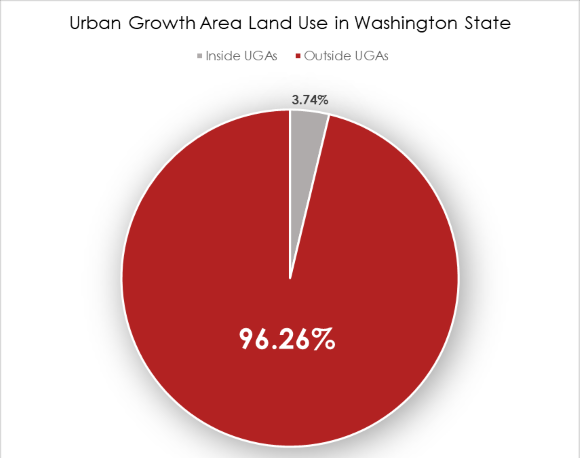July 28, 2025
A new study from the BIAW Center for Housing Studies zeroes in on one of the state’s most pressing housing challenges—land availability under the state’s Growth Management Act (GMA).
The study “How Land Limits Contribute to Washington’s Housing Crisis” reveals how the GMA’s restrictive urban growth areas (UGA) have driven land costs ever higher—pushing homeownership further and further out of reach for Washington families.
“This important study shows that only 3.74% of Washington’s land lies inside designated Urban Growth Areas,” said BIAW Executive Vice President Greg Lane. “In other words, for three decades now, Washington land-use policy has dictated that growth must fit into these tiny areas of our state.
“This significant limitation on where we can build new housing has been artificially, and dramatically, driving up the cost of homes in Washington. Better planning could help more families enjoy the benefits of home ownership.”
New homes in Washington are more than $200,000 more expensive than the national average—and only 20% of the state can afford to buy a median-priced home.
Key Findings
The study finds that:
- Land use regulations significantly limit the supply of buildable land, especially near job centers.
- Land prices have skyrocketed, often doubling over the last decade in many urban counties.
- Local growth management policies and zoning rules push new housing farther from cities, worsening commute times and emissions.
Policy Recommendations
To help alleviate the crisis, the report outlines several common-sense policy reforms:
- Expand Urban Growth Areas (UGAs): Allow counties to adjust UGAs to reflect real housing needs and economic growth. Under HB 1164 introduced during the 2025 legislative session, cities and counties planning under the GMA would be required to expand UGA boundaries during their next comprehensive plan update to include parcels adjacent to existing UGAs that:
- Are already developed or approved for residential use; and
- Have access to or plans for urban services.
“This approach prioritizes logical modest expansion while protecting critical areas such as agricultural lands, forests, and water sources,” the report says.
- Rezone for Density: Consider creating an intermediate zoning classification, such as a suburban designation, to allow for increased density into newly expanded UGAs without fully urbanizing areas.
- No net loss of usable land: Ensure there is no overall reduction in land available for housing when localities enact environmental protections, such as tree retention ordinances. If such measures reduce the amount of buildable land, the legislature could require the locality to periodically expand the UGA to compensate for the reduced supply.
- Plan for Realistic Growth: Require cities and counties to base their planning on updated data and housing demand—not outdated projections or politics.
“Thoughtful growth management can balance the need for additional developable land with protection for critical natural and agricultural areas,” Lane said. “We all enjoy the natural beauty of the Northwest. However, we need to help communities meet the urgent need for more homes across all income levels so our children and grandchildren can live here, too.”
Explore the Report
Visit housingstudies.biaw.com to read the full report and learn how smart land policy can make housing more affordable for all Washingtonians.








